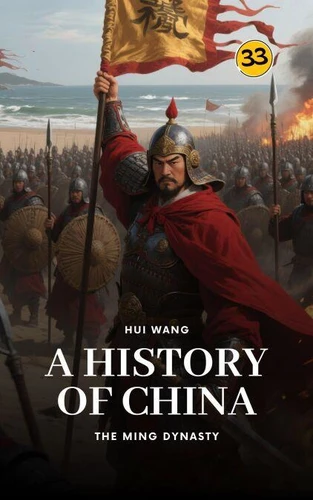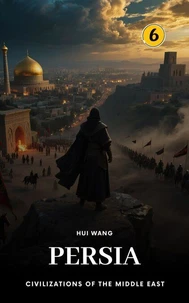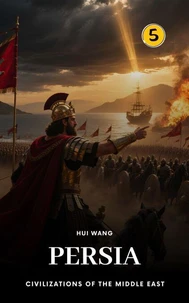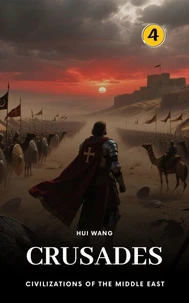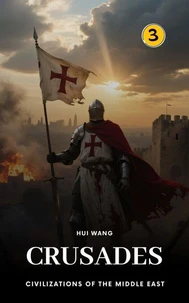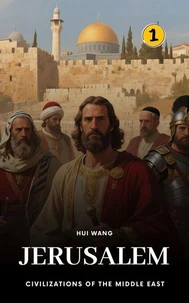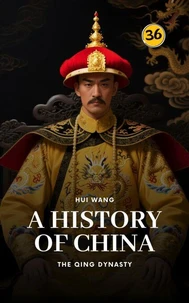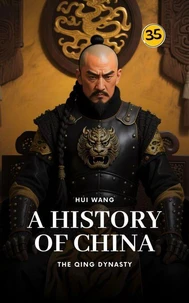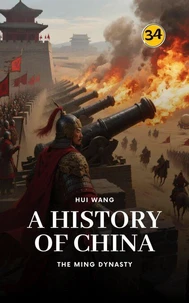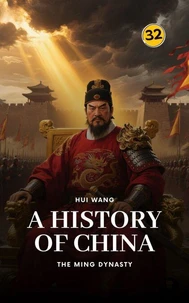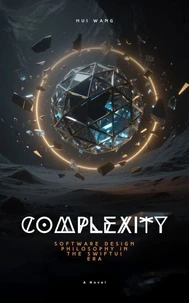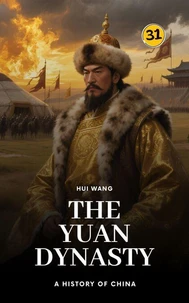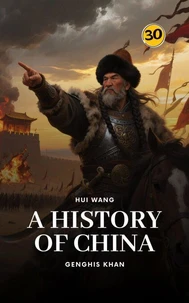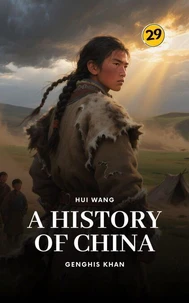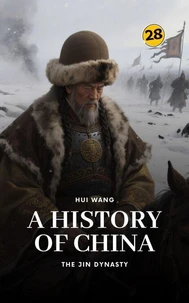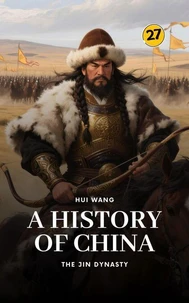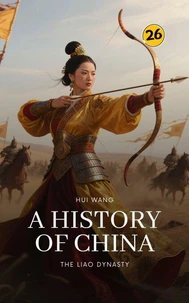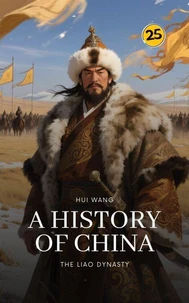The Ming Dynasty: A History of China. A History of China, #33
Par :Formats :
Disponible dans votre compte client Decitre ou Furet du Nord dès validation de votre commande. Le format ePub est :
- Compatible avec une lecture sur My Vivlio (smartphone, tablette, ordinateur)
- Compatible avec une lecture sur liseuses Vivlio
- Pour les liseuses autres que Vivlio, vous devez utiliser le logiciel Adobe Digital Edition. Non compatible avec la lecture sur les liseuses Kindle, Remarkable et Sony
 , qui est-ce ?
, qui est-ce ?Notre partenaire de plateforme de lecture numérique où vous retrouverez l'ensemble de vos ebooks gratuitement
Pour en savoir plus sur nos ebooks, consultez notre aide en ligne ici
- FormatePub
- ISBN978-91-90115-37-4
- EAN9789190115374
- Date de parution24/09/2025
- Protection num.pas de protection
- Infos supplémentairesepub
- ÉditeurHui Wang
Résumé
The Ming Dynasty: A History of China, PART TWO, carries you through two and a half centuries of drama, ambition, and sheer survival. It opens with the Crisis of Tumu Fortress in 1449, when the young Emperor Yingzong was captured and the whole realm seemed to teeter on the brink. From the unwavering courage of Yu Qian, who held Beijing against collapse, to the political tempest that later cost him his life, you'll see how precarious power could be behind the red walls of the Forbidden City.
Each chapter draws you nearer to the men and women who kept the dynasty standing against chaos, betrayal, and the whims of fate. When a fragile peace returned, new dangers arose within the palace itself. The narrative moves from the glittering ceremonies of the Chenghua court to the conscientious reforms of the Hongzhi Emperor, before corruption crept back in through powerful eunuch cliques and the rise-and spectacular fall-of Liu Jin, the era's most feared courtier.
You'll encounter the emperor who preferred playing at war-commonly identified with the indulgent Zhengde Emperor-and follow the furious debates of the Great Rites Controversy, where competing beliefs and political ambition collided in full view of the throne. Then came the Taoist-obsessed Jiajing Emperor, a sovereign consumed by the quest for immortality and divine favor. Far beyond the capital the seas boiled with unrest: Wang Zhi, the pirate-turned-maritime lord of the East China Sea, carved out a kingdom on the waves-an extensive network of trade and raiding bases that challenged coastal order-until Qi Jiguang, the soldier-poet and disciplined reformer of frontier forces, turned reluctant farmers into hardened troops and smashed the wokou threat.
Inside the Forbidden City, the upright official Hai Rui stood alone to speak blunt truth to power, a voice of integrity against an emperor given to fits of silence and fury. Change arrived with the Longqing Emperor, who loosened the strict sea bans and reopened ports to foreign trade, and with Zhang Juzheng, the brilliant but divisive grand secretary whose fiscal and administrative reforms guided the young Wanli Emperor through what became the Ming's last bright revival.
Yet ambition, exhaustion, and fresh conflicts soon returned. From rebellions in the southwestern borderlands (notably uprisings of local tusi and indigenous groups, rather than a single clearly named "Babai" revolt) to Toyotomi Hideyoshi's dream of conquest, the empire was dragged into the Imjin War (1592-1598). In that terrible theatre, Ming generals like Li Rusong and Korean heroes such as Admiral Yi Sun-sin clashed with Japanese forces across the Korean peninsula in a conflict that shook the balance of power throughout East Asia.
The final chapters sweep you into the Bozhou Rebellion and the burning of Hailongtun - the last fortress where Yang Yinglong made his desperate, heroic stand against the Ming imperial armies. This book does more than trace the rise and fall of rulers; page by page it conjures the spirit of a civilization at its height - proud, brilliant, and unmistakably human. If you've ever wanted to feel China's history come alive through the voices of real people, this journey through the Ming world will have you turning pages late into the night.
Each chapter draws you nearer to the men and women who kept the dynasty standing against chaos, betrayal, and the whims of fate. When a fragile peace returned, new dangers arose within the palace itself. The narrative moves from the glittering ceremonies of the Chenghua court to the conscientious reforms of the Hongzhi Emperor, before corruption crept back in through powerful eunuch cliques and the rise-and spectacular fall-of Liu Jin, the era's most feared courtier.
You'll encounter the emperor who preferred playing at war-commonly identified with the indulgent Zhengde Emperor-and follow the furious debates of the Great Rites Controversy, where competing beliefs and political ambition collided in full view of the throne. Then came the Taoist-obsessed Jiajing Emperor, a sovereign consumed by the quest for immortality and divine favor. Far beyond the capital the seas boiled with unrest: Wang Zhi, the pirate-turned-maritime lord of the East China Sea, carved out a kingdom on the waves-an extensive network of trade and raiding bases that challenged coastal order-until Qi Jiguang, the soldier-poet and disciplined reformer of frontier forces, turned reluctant farmers into hardened troops and smashed the wokou threat.
Inside the Forbidden City, the upright official Hai Rui stood alone to speak blunt truth to power, a voice of integrity against an emperor given to fits of silence and fury. Change arrived with the Longqing Emperor, who loosened the strict sea bans and reopened ports to foreign trade, and with Zhang Juzheng, the brilliant but divisive grand secretary whose fiscal and administrative reforms guided the young Wanli Emperor through what became the Ming's last bright revival.
Yet ambition, exhaustion, and fresh conflicts soon returned. From rebellions in the southwestern borderlands (notably uprisings of local tusi and indigenous groups, rather than a single clearly named "Babai" revolt) to Toyotomi Hideyoshi's dream of conquest, the empire was dragged into the Imjin War (1592-1598). In that terrible theatre, Ming generals like Li Rusong and Korean heroes such as Admiral Yi Sun-sin clashed with Japanese forces across the Korean peninsula in a conflict that shook the balance of power throughout East Asia.
The final chapters sweep you into the Bozhou Rebellion and the burning of Hailongtun - the last fortress where Yang Yinglong made his desperate, heroic stand against the Ming imperial armies. This book does more than trace the rise and fall of rulers; page by page it conjures the spirit of a civilization at its height - proud, brilliant, and unmistakably human. If you've ever wanted to feel China's history come alive through the voices of real people, this journey through the Ming world will have you turning pages late into the night.
The Ming Dynasty: A History of China, PART TWO, carries you through two and a half centuries of drama, ambition, and sheer survival. It opens with the Crisis of Tumu Fortress in 1449, when the young Emperor Yingzong was captured and the whole realm seemed to teeter on the brink. From the unwavering courage of Yu Qian, who held Beijing against collapse, to the political tempest that later cost him his life, you'll see how precarious power could be behind the red walls of the Forbidden City.
Each chapter draws you nearer to the men and women who kept the dynasty standing against chaos, betrayal, and the whims of fate. When a fragile peace returned, new dangers arose within the palace itself. The narrative moves from the glittering ceremonies of the Chenghua court to the conscientious reforms of the Hongzhi Emperor, before corruption crept back in through powerful eunuch cliques and the rise-and spectacular fall-of Liu Jin, the era's most feared courtier.
You'll encounter the emperor who preferred playing at war-commonly identified with the indulgent Zhengde Emperor-and follow the furious debates of the Great Rites Controversy, where competing beliefs and political ambition collided in full view of the throne. Then came the Taoist-obsessed Jiajing Emperor, a sovereign consumed by the quest for immortality and divine favor. Far beyond the capital the seas boiled with unrest: Wang Zhi, the pirate-turned-maritime lord of the East China Sea, carved out a kingdom on the waves-an extensive network of trade and raiding bases that challenged coastal order-until Qi Jiguang, the soldier-poet and disciplined reformer of frontier forces, turned reluctant farmers into hardened troops and smashed the wokou threat.
Inside the Forbidden City, the upright official Hai Rui stood alone to speak blunt truth to power, a voice of integrity against an emperor given to fits of silence and fury. Change arrived with the Longqing Emperor, who loosened the strict sea bans and reopened ports to foreign trade, and with Zhang Juzheng, the brilliant but divisive grand secretary whose fiscal and administrative reforms guided the young Wanli Emperor through what became the Ming's last bright revival.
Yet ambition, exhaustion, and fresh conflicts soon returned. From rebellions in the southwestern borderlands (notably uprisings of local tusi and indigenous groups, rather than a single clearly named "Babai" revolt) to Toyotomi Hideyoshi's dream of conquest, the empire was dragged into the Imjin War (1592-1598). In that terrible theatre, Ming generals like Li Rusong and Korean heroes such as Admiral Yi Sun-sin clashed with Japanese forces across the Korean peninsula in a conflict that shook the balance of power throughout East Asia.
The final chapters sweep you into the Bozhou Rebellion and the burning of Hailongtun - the last fortress where Yang Yinglong made his desperate, heroic stand against the Ming imperial armies. This book does more than trace the rise and fall of rulers; page by page it conjures the spirit of a civilization at its height - proud, brilliant, and unmistakably human. If you've ever wanted to feel China's history come alive through the voices of real people, this journey through the Ming world will have you turning pages late into the night.
Each chapter draws you nearer to the men and women who kept the dynasty standing against chaos, betrayal, and the whims of fate. When a fragile peace returned, new dangers arose within the palace itself. The narrative moves from the glittering ceremonies of the Chenghua court to the conscientious reforms of the Hongzhi Emperor, before corruption crept back in through powerful eunuch cliques and the rise-and spectacular fall-of Liu Jin, the era's most feared courtier.
You'll encounter the emperor who preferred playing at war-commonly identified with the indulgent Zhengde Emperor-and follow the furious debates of the Great Rites Controversy, where competing beliefs and political ambition collided in full view of the throne. Then came the Taoist-obsessed Jiajing Emperor, a sovereign consumed by the quest for immortality and divine favor. Far beyond the capital the seas boiled with unrest: Wang Zhi, the pirate-turned-maritime lord of the East China Sea, carved out a kingdom on the waves-an extensive network of trade and raiding bases that challenged coastal order-until Qi Jiguang, the soldier-poet and disciplined reformer of frontier forces, turned reluctant farmers into hardened troops and smashed the wokou threat.
Inside the Forbidden City, the upright official Hai Rui stood alone to speak blunt truth to power, a voice of integrity against an emperor given to fits of silence and fury. Change arrived with the Longqing Emperor, who loosened the strict sea bans and reopened ports to foreign trade, and with Zhang Juzheng, the brilliant but divisive grand secretary whose fiscal and administrative reforms guided the young Wanli Emperor through what became the Ming's last bright revival.
Yet ambition, exhaustion, and fresh conflicts soon returned. From rebellions in the southwestern borderlands (notably uprisings of local tusi and indigenous groups, rather than a single clearly named "Babai" revolt) to Toyotomi Hideyoshi's dream of conquest, the empire was dragged into the Imjin War (1592-1598). In that terrible theatre, Ming generals like Li Rusong and Korean heroes such as Admiral Yi Sun-sin clashed with Japanese forces across the Korean peninsula in a conflict that shook the balance of power throughout East Asia.
The final chapters sweep you into the Bozhou Rebellion and the burning of Hailongtun - the last fortress where Yang Yinglong made his desperate, heroic stand against the Ming imperial armies. This book does more than trace the rise and fall of rulers; page by page it conjures the spirit of a civilization at its height - proud, brilliant, and unmistakably human. If you've ever wanted to feel China's history come alive through the voices of real people, this journey through the Ming world will have you turning pages late into the night.

